#peter paul rubens-the four continents
Text

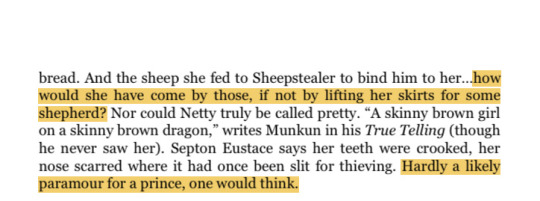
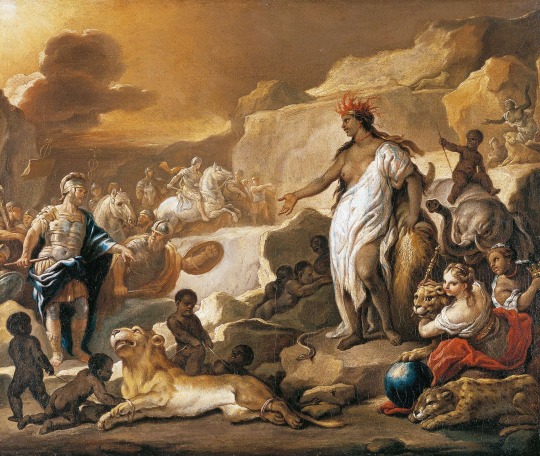

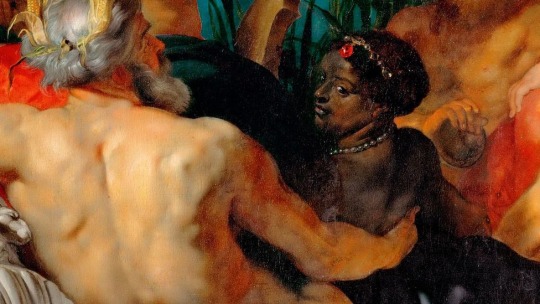



The many judgements made upon Nettles
Fire & Blood 🔥🐉
#nettles f&b#hotd spoilers#netty#hotd#valyrianscrolls#nettles asoiaf#nettles#hotdedit#house of the dragon#asoiafedit#jan boeckhorst-allegory of africa#luca giordano-africa#peter paul rubens-the four continents#francesco solimena-allegory of the continent africa#bnedit#bnhotdedit#dettles#this post was brought to you by queue 📺
139 notes
·
View notes
Text

Title: The Four Continents
Artist: Peter Paul Rubens
Date: 1612
Style: Baroque
Genre: Allegorical Painting
69 notes
·
View notes
Text
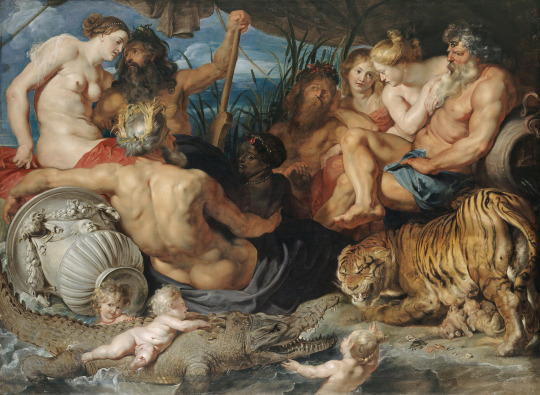
Peter Paul Rubens - The Four Continents
18 notes
·
View notes
Photo
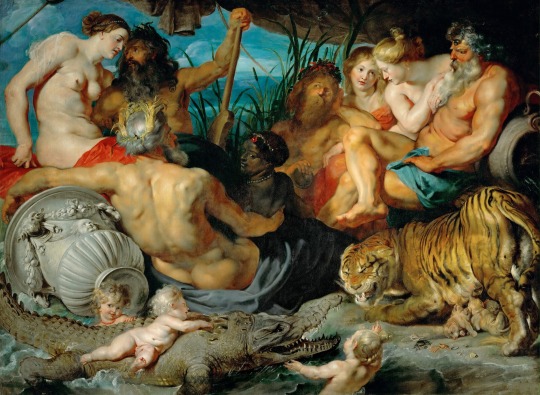
Peter Paul Rubens The Four Continents ca.1615
50 notes
·
View notes
Text

The Four Continents, Peter Paul Rubens
1 note
·
View note
Photo

Peter Paul Rubens - The Four Rivers of Paradise (~1613-1615)
#Peter Paul Rubens#The Four Rivers of Paradise#The Four Continents#damn hard to find paintings of black people unfortunately#17th century#I really like the symbolism of this one#the tiger representing asia is coiled protectively over her cubs#the men are continents and the women rivers#it was painted by Rubens during a period of relative peace (at least between Spain and the Dutch)#And so all the continents and rivers kicking it together in peace seems a very hopeful vision#Kinda shit that the Americas (in the back) and Asia (on the right) are both depicted as white tho....#baroque#french baroque
2 notes
·
View notes
Photo

Cassisy Artwork Peter Paul Rubens the four continents Canvas Painting & Calligraphy Print Living Room Decor Life Art No Framed
#cassisy#artwork#peter#paul#rubens#four#continents#canvas#painting#calligraphy#print#living#room#decor#life#art#framed#home
0 notes
Photo

The Four Continents, 1614, Peter Paul Rubens
Medium: oil,canvas
247 notes
·
View notes
Photo

The Four Rivers of Paradise or The Four Continents, painted by Peter Paul Rubens, 1615 (Baroque Movement)
Black women in Western Art
#black women#baroque#peter paul rubens#art#art academia#dark academia#light academia#black academia#painting
8 notes
·
View notes
Text
Here. The Black Presence in Western Art
This month, the Rembrandt Museum in Amsterdam opened a new exhibition entitled HERE. BLACK IN REMBRANDT’S TIME. The exhibition overlaps with The Hyde Collection’s presentation of the art of an accomplished, but little known, African American artist, Dox Thrash (1893-1965): DOX THRASH, BLACK LIFFE AND THE CARBORUNDUM MEZZOTINT. The Thrash exhibition is the first of three successive winter shows at The Hyde that will highlight African American art.

Dox Thrash (American, 1893–1965), The Champ, c. 1937–39, aquatint, private collection
I began this series with Dox Thrash, in part, because, as an artist, he fits neatly into the styles and history of western art that we know so well at The Hyde. He trained at the School of the Art Institute of Chicago in the western tradition. Henry Ossawa Tanner (1859-1937), whose portrait by Thomas Eakins graces the main stairs in Hyde House, was an inspiration to Thrash. Indeed, he may have met Tanner in France following the end of World War I, in which Thrash served and was wounded.

Thomas Eakins, (American, 1844-1916), Portrait of Henry O. Tanner, ca. 1897, oil on canvas, 29 5/8 x 26 x 2 1/4 in. The Hyde Collection, Glens Falls, NY. Gift of Charlotte Pruyn Hyde, 1971.16.
Inspired by the Harlem Renaissance, Thrash was driven to make black life - his childhood experiences in rural George, his time on the road “ho-boing” (to use his term) as a vaudeville performer, and his professional life as an leading citizen of the black community in Philadelphia - the subject of art. Almost alone among African American artists of his day, Thrash appropriated the European tradition of the reclining female nude for the black female body. We see this most assertively in Thrash’s print Siesta (ca 1944-48), which was inspired by John Vanderlyn’s infamous painting, Ariadne Asleep on the Island of Naxos (1809–14). Vanderlyn’s painting, although clearly within the European tradition established in the Renaissance by such a master as Titian - think of his Venus of Urbino (1538) at the Uffizi Gallery - scandalized Protestant ,and particularly Quaker, Philadelphia. Thrash’s reclining nude is proudly African American. Images of the black female nude had long be problematic in American art and society because of the country’s history of abusing enslaved women.

Detail: Dox Thrash, (American, 1893–1965), Siesta, ca. 1944–48, carborundum mezzotint, on loan from Dolan/Maxwell

John Vanderlyn (American, 1776-1852), Ariadne Asleep on the Island of Naxos, 1809–14, oil on canvas, 68½ x 87 in. Pennsylvania Academy of the Fine Arts, 1809–14. © Pennsylvania Academy of the Fine Arts.
A particularly powerful section of the exhibition contains Thrash’s portraits of African Americans. Most are not identified; rather, they have titles such as Woman in Blue (1940s) and Head of a Young Man (1940-50). Yet they are painted with such a powerful sense of character. These are clearly portraits of people Thrash knew personally. Their individualism shines through. Sporting a stylish hat, she is not a mammy; dressed in a tie, he is not a laborer – the two characteristic professions given to African Americans in the overwhelming White, racist media. These are successful, proud, self-confident members of the black urban middle class.

Dox Thrash (American, 1893–1965), Woman in Blue, 1940s, watercolor, private collection
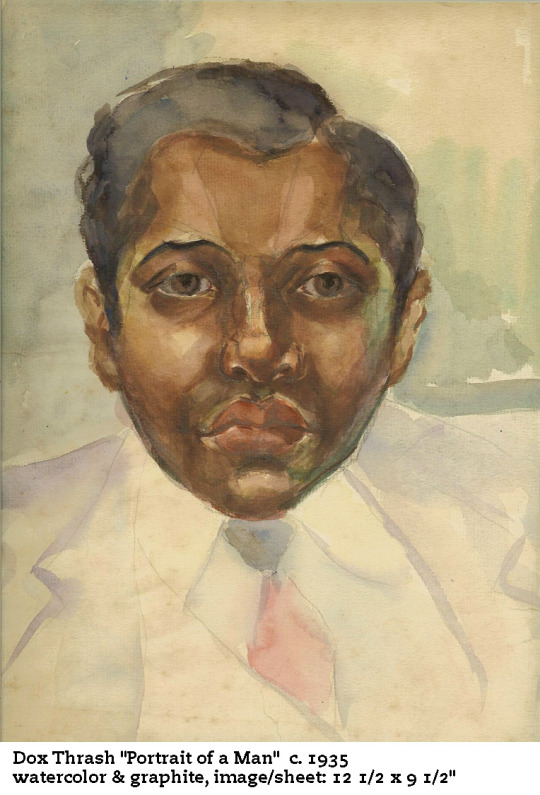
In that they are without specific identities and represent a type, such images by Thrash relate to a well-established genre in European painting, the tronie. Particularly popular in the seventeenth century, the tronie was a type of genre painting in portrait format. It was an artistic exercise in the depiction and capture of human states and emotions, such as old age, anger, and laughter. The emphasis was upon the realistic portrayal of the particular emotion without necessarily conveying a sense of the individual or the model. Leonardo da Vinci (1454-1519) frequently juxtaposed tronies of old age and youth in his sketchbooks.
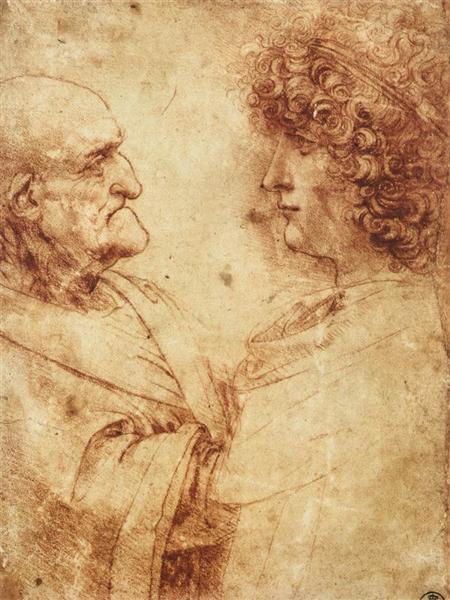
Leonardo da Vinci (Italian, 1452-1519), Heads of an old man and a youth, ca.1495, chalk, paper, Uffizi Gallery. © Gabinetto Fotografico delle Gallerie degli Uffizi
Both Peter Paul Rubens (1577-1640) and Rembrandt Van Rijn (1606-1669) painted tronies. But both also captured something of the character and identity of their live models.
When Rembrandt first settled in Amsterdam in 1632, he lived on Judenbeestraat (Jewish Broad Street) in a house that is now the Rembrandt House Museum. He not only befriended Jewish intellectuals like Samuel Menasseh ben Israel, whose portrait he etched in 1636, but he drew tronies based upon his Jewish neighbors. These he employed in his paintings of Biblical scenes, as Pharisees, high priests, and the like to lend his images an air of historical accuracy.
Among the neighbors who sat for Rembrandt so that he could develop his stock of characters were members of Amsterdam’s small African community. They too lived in the Judenbreestraat district. Although the Netherlands was heavily involved in the slave trade, Dutch law did not recognize slavery on Dutch soil. Scholars associated with the Rembrandt House Museum’s new exhibition have documented the lives of approximately 100 Africans living in Amsterdam. Most of the women worked as servants, many in the households of Sephardic Jews exiled from Spain and Portugal, two European countries that recognized the state of slavery on their soil. Many of the men were Brazilian sailors, who presumably jumped ship when they arrived in port to claim their freedom.
The exhibition contains seven Rembrandt images and forty-nine works by his contemporaries. The works are noteworthy for their lack of racist caricature and stereotyping. Many of the characters are represented with sympathy and compassion. They are ennobled by everyday jobs rather than disempowered, as so often in eighteenth-century portraiture, by appearing as servants.
In our collection, we have a superb painting that epitomizes this moment in seventeenth-century Europe when Africans were seen and recorded with sympathy and compassion, as individual human beings before the onset of racial stereotyping. The painting is my personal favorite in the collection, Rubens’ stunning Head of a Moor (ca.1618).
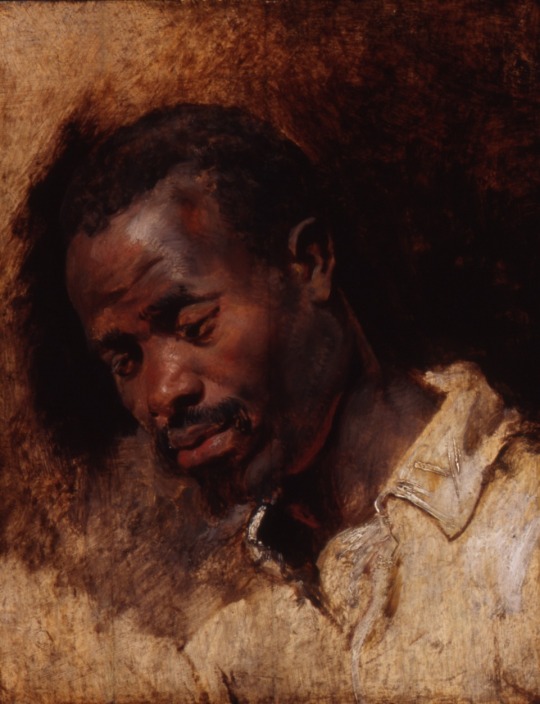
Peter Paul Rubens, (Flemish, 1577-1640), Head of a Moor, ca. 1620, oil on panel, 29 3/4 × 26 1/2 in. The Hyde Collection, Glens Falls, NY, Gift of Charlotte Pruyn Hyde, 1971.40.
Like any other tronie, this is an artistic exercise for Rubens. He is trying to solve the question, as a master colorist: How do I convincing render the face of an African man? It will not do for him to simply warm up a brown, add some white for highlights and black for shadows, as European artists had done in generations past. Compare Ruben’s head with the African magus in The Hyde’s Adoration of the Magi by an Antwerp Mannerist, ca. 1520. Rubens uses a stroke of red to define the underside of his African sitter’s chin. Red warms his skin tones in lighted areas. The shadows on the side of his face are made up of strokes of blue-grey and deep blue and black.

Antwerp Mannerist, after Jan de Beer (Flemish, ca.1475 - ca.1528), Adoration of the Magi, ca. 1520, oil on oak panel, 29 x 25 1/4 in. The Hyde Collection, Glens Falls, NY, Bequest of Charlotte Pruyn Hyde, 1971.2.
Rubens knew this man and this was not the first time that he had painted him. The Royal Museums of Fine Arts, Belgium has an oil study in which Rubens examines the same man from four different angles.
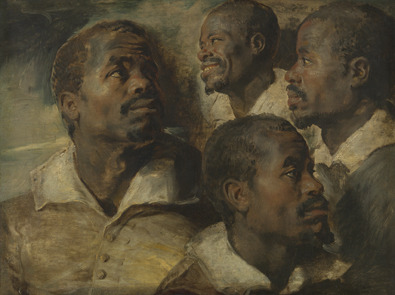
Peter Paul Rubens (Flemish, 1577-1640), Four Studies for the Head of a Moor, 1613-15, oil on canvas, 51 x 66 cm. The Royal Museum of Fine Arts Belgium, inv. 3716. Musées royaux des Beaux-Arts de Belgique, Bruxelles / photo : J. Geleyns.
That Rubens brought a black man in his studio to sit for him was such a significant event that others in the studio made their own studies. One, by an unknown hand, now hangs at the J. Paul Getty Museum. Anthony Van Dyck, who worked briefly in Rubens’ studio, included a profile drawing of this man smiling on the lower right of a sheet of eleven pen and ink head studies now in the Chatsworth Collection in Britain.
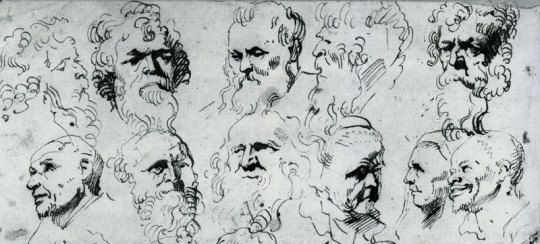
Anthony Van Dyck (Flemish, 1599-1641), Records of Eleven Head Studies, 1618-20, pen and ink, Devonshire Collection, Chatsworth.
Who the man was and how Rubens came to know him and to invite him to his studio at least twice over the course of a few years is not known. In the first half the seventeenth century, Antwerp was Europe’s leading port. Portuguese and Spanish merchants sent their ships directly there from their African and New World colonies. The man may have been a servant or have arrived as a sailor off one of those vessels.
This unknown African was not even the first Rubens painted. While in Rome in 1609, Rubens executed an oil study of an African man wearing a turban. The work is now at the Getty Museum. Shortly thereafter, he used the head to make a free copy of a famous portrait by Jan Cornelisz. Vermeyen (1500-1559) of a Tunisian king, Mulay Ahmad. Rubens’ version survives at the Museum of Fine Arts, Boston, though Vermeyen’s is lost.

Peter Paul Rubens (Flemish, 1577-1640), The Head of an African Man Wearing a Turban, 1609–11, oil on paper laid down on panel, 21 1/4 × 15 1/2 in. The J. Paul Getty Museum, 2018.48. Digital image courtesy of the Getty's Open Content Program.
Rubens employed the image of this turbaned African as the model for the Black King in several altarpieces depicting the Adoration of the Magi. A popular subject for altarpieces at the time, the Adoration of the Magi afforded artists one of their few opportunities to paint non-Europeans. In the later Middle Ages, the three kings had come to represent the three known continents. In Counter-Reformation theology, black Africans represented the Gentiles; those around the world willing to receive the Word and become Christians.

Peter Paul Rubens (Flemish, 1577-1640), The Adoration of the Magi, 1609, 1628-29 oil on canvas, 355.5 x 493 cm. The Prado Museum. © The Prado Museum.
Africansalso appeared as attendants in mythological and historical paintings. Rubens used two of the heads from the Brussels oil study in classical paintings: The Drunken Silenus, (1618-25) at the Alte Pinakothek in Munich and Nature Adorned by the Three Graces (ca. 1615) at the Kelvingrove Art Gallery and Museum, Glasgow. No surviving work has been found that specifically uses the head from The Hyde’s study.

Peter Paul Rubens (Flemish, 1577-1640), The Drunken Silenus, 1618–1625, oil on canvas, 212 x 214 cm. The Alte Pinakothek, Munich, 319. © Bayerische Staatsgemäldesammlungen.

Peter Paul Rubens (Flemish, 1577-1640) and Jan Brueghel the Elder (Flemish 1568-1625), Nature Adorned by the Three Graces, ca. 1618, oil on panel, 42 x 28.5 in., Kelvingrove Art Gallery and Museum, Glasgow. Commons.wikimedia.com.
At The Hyde, we will explore the works by African American artists again in the winter of 2021 with the exhibition THE HARMON & HARRIET KELLEY COLLECTION OF AFRICAN AMERICAN ART: WORKS ON PAPER. Dox Thrash will make a return along with other artists who sought to insert the black experience into the European art traditions in which they had been schooled. There will be others, like Horace Pipin and Jacob Lawrence, who used African rather than European models to create a discernibly black art. In the following winter, we will present ROBERT BLACKBURN & AMERICAN PRINTMAKING. This exhibition will highlight the work of this under-represented abstract printmaker, while also placing him in the context of his contemporaries, many of whom were white and are, thus, better known.
The Hyde’s Rubens and Eakins paintings discussed here are on permanent display in Hyde House. In addition, we frequently put on view in the Education Wing Sam Gilliam’s Asking. I hope it will not be too much longer before we can welcome you back to The Hyde and you can explore our works discussed here, in person.

Sam Gilliam, (American, born 1933), Asking, 1972, Acrylic on canvas, 82 x 76 1/4 in. The Hyde Collection, Glens Falls, NY, Gift of Dr. Robert and Jane Lewit, 2010.17. ©1972 Sam Gilliam
#hydecollection#doxthrash#rembrandt#goya#rubens#museum of fine arts boston#j paul getty museum#sam gilliam
2 notes
·
View notes
Photo

The Four Rivers of Paradise | Peter Paul Rubens | 1615 | Kunsthistorisches Museum, Vienna
“The Four Rivers of Paradise, is a painting by Flemish artist Peter Paul Rubens, made in the 1610s. It depicts the female personifications of, what, at the time, were believed to be four continents (Europe, Asia, Africa and America) sitting with the personifications of their respective major rivers – the Danube, the Ganges, the Nile and the Río de la Plata. Europe is shown on the left, Africa in the middle, Asia on the right and America behind it, to the left. The tigress, protecting the cubs from the crocodile, is used as a symbol of Asia. The personification of the Danube holds a rudder. The bottom part of the painting shows several putti. Painted during a period of truce between the Dutch Republic and Spain, the river allegories and their female companions in a lush, bountiful setting reflect the conditions that Rubens hoped would return to Antwerp after military hostilities.”
35 notes
·
View notes
Text



their bedrooms were adjoining, and that Daemon often gave her gifts and even shared a bath with her. The Rise of the Dragon🔥
Final Girls of the Dance Week🐉-Day 1
Favorite Book Moment: Maidenpool
#nettles#daemon targaryen x nettles#daemon targaryen#dettles#daemon x nettles#nettles x daemon#asoiafedit#valyrianscrolls#❤️🔥#art: the four continents by Peter Paul Rubens#nettles asoiaf#netty#nettles f&b#bnedit#final girls of the dance week 2024
8 notes
·
View notes
Photo

The Four Continents, 1612, Peter Paul Rubens
Size: 208x283 cm
Medium: oil, canvas
29 notes
·
View notes
Text
不要瞎掰好嗎:近代歐洲如何描繪超稀有的「異國老虎」
https://reurl.cc/oeVelq
文/戴郁文、王健安
約莫1616年,畫家魯本斯(Peter Paul Rubens)應巴伐利亞選帝侯馬克西米連一世的委託,完成了〈狩獵老虎〉(La Chasse au Tigre,見圖2)繪畫主題由八個人和七隻貓科動物在水邊搏鬥的場景構成:左右側是已被壓制在地的獅子與美洲豹,畫面正中央,有一匹軀幹成S型線條的馬匹,一隻老虎正以無比兇猛的姿態啃咬著身著綠衣、面容驚恐的騎士,勝負猶未可知。而在畫面右側,還可見到另一隻老虎,屈伏身軀保護著三隻幼虎,與畫面正中央的氛圍形成強烈對比。
〈狩獵老虎〉寫實卻又奇幻。寫實的是,魯本斯繪製的老虎,從體態到斑紋,生動寫實的程度,皆遠遠超乎當代其他藝術作品的成就。更甚於此,魯本斯的動物描繪,結合其對色彩與光影的傑出應用,使畫中所有人物及物件,都凝結在激烈動作中的瞬間,老虎的肌理、毛皮紋路與臉部神情更顯真實。而且,〈狩獵老虎〉是幅高248公分、寬318公分巨型油畫,更能體現這些細微之處。
奇幻的是,亞洲虎、美洲豹和非洲獅子這三種貓科動物,跨越地理限制,共同出現在這個場景,對抗身著伊斯蘭風格戰袍或歐式盔甲的騎士,那位扳開獅嘴的勇士,顯然也是借用自聖經中擁有神力的參孫。從科學、藝術等各方面來看,〈狩獵老虎〉無疑具有極高的觀賞價值。
〈狩獵老虎〉並非魯本斯將老虎融入畫作的唯一嘗試。他的另一名作〈四大洲〉(The Four Continents,見圖3)中,也有一頭母老虎保護懷中的四隻幼虎,威嚇著進逼中的鱷魚。同樣的,從姿態、神情到毛色與光影,〈四大洲〉也以高度寫實的戲劇性效果令人印象深刻。
魯本斯的老虎圖像確實令人驚豔,對17世紀的觀賞者來說,還能獲得視覺感官以外的震撼,讓畫作擁有者選帝侯馬克西米連一世更顯不凡。這一切,都和近代歐洲的動物研究、地理大發現有密不可分的關係。
以歐洲生態環境來說,老虎是個來自亞洲外來物種,即便如此,老虎的形象在許久以前就已根植於歐洲文化。早在古典時代,就有許多與老虎接觸的紀錄,特別是波斯帝國、亞歷山大帝國,以及後來的羅馬帝國,更創造了歐亞之間得已密集交換異國動物的環境。
在古羅馬作家維吉爾(Virgil)的作品中,酒神巴庫斯(Bacchus)出現時,總是伴隨著老虎在內的貓科動物,表現出無比歡騰的熱鬧氛圍;當然,老虎也是古羅馬人的娛樂元素,不時出現在慶典遊行或鬥獸表演。而像是老普林尼(Pliny the Elder)這類博物學者,理所當然地在作品《自然史》(Naturalis Historia)中,寫下來關於老虎的故事與形象。
但到了中世紀,情況有些許改變。歐洲文明依舊知道老虎的存在,卻顯得越來越無法精確描繪其樣貌型態,而且更加誇大某些刻板印象。例如在中世紀早期出現的動物學作品《博物學者》(Physiologus),如此草率敘述老虎的外觀:「像獅子的四腳動物,不過有更長、更彎曲的鼻子。」後續內容,依循著自老普林尼以來的說法,不斷強調其「敏捷迅速、充滿母愛」的性情。
至少有兩個原因可以解釋以上現象。首先,自從跨洲帝國消失後,歐洲本地只剩下一些可直接看到老虎的零星機會。其次,更為關鍵的因素是,中古歐洲的觀察者 (或研究者) 並不以現代實證精神觀察動物,而是更加在意動物所具備的道德寓意或宗教象徵。《博物學者》在講述大象時,留下了一些顯然有違現實的描述:「當大象倒下時,因為牠的腳沒有關節,所以無法重新站立。」該書繼續說道,如果真有大象倒下,其他大象也無能為力,最後,只能依靠小象的象牙,將倒下的大象扶立起來。
在《博物學者》的世界觀中,這頭小象便代表著拯救人類的耶穌,一旁觀看的大象,寓意著人類無用的律法。《博物學者》更進一步提到,大象具有高度節操,天性上與邪惡生物相對立,所以極度討厭使人類被逐出伊甸園的蛇類。
至於老虎在《博物學者》究竟扮演何種宗教意涵,因為相關段落已經佚失不得而知,或許是將老虎的母愛類比成上帝對人類的愛——總之可以確定的是,老虎真實具體的模樣,並非作者關心的焦點。
▌來自新世界的異國動物
在15世紀下半,歐洲歷經的重大事件,直接影響了觀看動物的方式,尤其是由葡萄牙開啟的海外探險。這不僅擴大歐洲貿易路線,更得已從世界各地,直接進口此前罕見的異國生物。當代歐洲的強大統治者,如法國的法蘭索瓦一世 (Francis I)、哈布斯堡的魯道夫二世(Rudolf II)等人,都留下了包括老虎在內,飼養各種異國動物的紀錄。
與此同時,歐洲自中世紀晚期以來,從文本翻譯、校譯,到寫實的肖像畫、自然風景畫,各領域成果,無一不透露出越來越嚴謹的考據精神。正巧,統治者們飼養的動物,以及收藏的標本,為知識圈、藝術家,乃至於一般大眾提供了絕佳觀察對象,大力促進近代動物學研究的發展。
托賽爾(Edward Topsell)出版的《四足動物史》(The History of four-footed Beast),雖然還是延續老虎自古典時代以來的各種奇特形象,但也增添更加豐富且具體的文字描述:
「這頭野獸的身體類似母獅,臉和嘴巴亦是如此......腳像貓,短脖子,毛皮散布著花紋,但不是像豹的圓形花紋......(花紋) 只有一個顏色,而且不是方形就是長條形。」
該書慣有的版畫插圖,視覺化以上文字描繪,表情有點呆滯,但任何人都能從中立即領會老虎的外觀(見圖7)。
正當葡萄牙,以及後期加入的西班牙不斷擴張海外殖民帝國,歐洲也出現越來越多關於老虎的記錄。1580年,蒙田在佛羅倫斯旅遊時,就在當地親眼見到老虎,他說:「(老虎)的體型大如敖犬,但形態像貓,且帶有或黑或白的花紋。」大約同時代的動物圖像,也更著重於寫實、生動的外觀描繪,著名版畫家坦佩斯塔(Antonio Tempesta)便以此為原則,創作了一系列動物百科圖鑑,老虎當然也在其中(見圖8)。
▌新時代的生命力
魯本斯最重要的人生經歷之一,是從1600年起,開始在義大利長達八年的旅居生活。這段時間他受聘於曼圖雅公爵溫琴佐一世(Vincenzo I Gonzaga),從而有了到佛羅倫斯、熱那亞、羅馬和威尼斯等城市臨摹名畫、參訪各地收藏室的機會。魯本斯因其博雅知識及語言才能,還加入外交使節團的行動。
1608年,31歲的魯本斯回到安特衛普定居,此時安特衛普已被阿姆斯特丹取代,不再是北歐最重要的港口與文化中心,但魯本斯響亮的名氣與傑出的繪畫本領,使他立刻受雇於負責統治尼德蘭的奧地利大公夫婦,擔任宮廷畫家,迅速成為歐洲最受敬重的畫家之一,在阿爾卑斯山以北雄霸一方。
在藝術成就外,魯本斯也在外交事務留下顯著功名。他曾奉命走訪馬德里及倫敦,調停西英兩國的紛爭。魯本斯很有可能就是在這些經歷中,看到各地宮廷收藏的動物圖像、資料,甚至是親眼觀察活體動物。
魯本斯當年完成的〈狩獵老虎〉其實是系列畫作之一,還有另外三幅:〈狩獵野豬〉、〈狩獵河馬與鱷魚〉、〈狩獵獅子〉。
除了野豬是歐洲傳統狩獵活動中常見的獵物,老虎、河馬、鱷魚、獅子等都是17世紀歐洲少見的異國動物。魯本斯創作時的參考資料,便有可能也包括了馬克西米連一世的收藏與飼養的動物。況且,魯本斯的贊助者及交友圈遍及歐洲各國,他也與當代傑出藝術家保持友誼與合作關係,如老揚·勃魯蓋爾(Jan Brueghel the Elder)及動物繪畫大師斯奈德斯(Frans Snyders)。擁有如此豐富的人脈及自身歷練,無怪乎魯本斯能夠完成在當時最為精緻的老虎圖像。觀者所見,不僅是精美的狩獵場景,還有當代歐洲最新的動物知識。
魯本斯的老虎圖像當然��有傳統的一面,老虎保護幼虎的場景,便有意採用自古以來「老虎極有母愛」的刻板印象(見圖12)。
但在魯本斯所處的時代,歐洲的動物研究漸漸脫離傳統論述,更直觀地描繪與研究動物外觀及其習性,不再只是個基於人類需求,作為道德觀或宗教觀的載體。〈狩獵老虎〉中的兇猛老虎,不僅跳出整幅畫作最有戲劇性的一瞬間,也充滿了新時代降臨時的旺盛生命力。
文章複製來源-聯合新聞網
0 notes
Photo
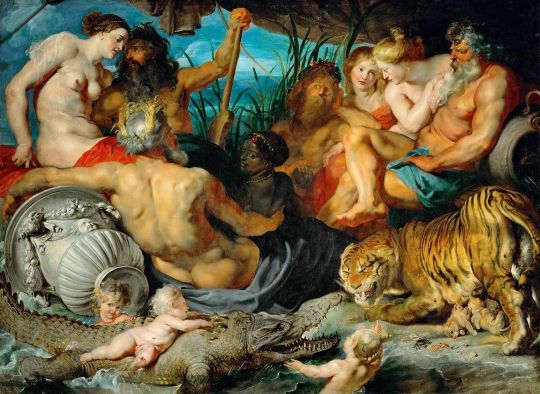
Artwork: The Four Continents (Europe, Asia, Africa and America) Artist: Peter Paul Rubens (Dutch 28 June 1577 – 30 May 1640) was a Flemish artist and diplomat ) Created: ca. 1614-1615 Medium: Oil on canvas Dimensions: 209 x 284 cm Location: Kunsthistorisches Museum of Art History, Vienna, Austria ———————————- Each of the four continents (Europe, Asia, Africa and America) is represented by four women, each woman is accompanied by the divinity that corresponds to the most important river in that geographical area. ———————————— #webgalleryofvisualart #nakedwomenandmaleinart #rubens #baroque #oiloncanvas #nakedwomenandmaleinart https://www.instagram.com/p/CLkQzH1rks5/?igshid=5p1u55hnxb78
0 notes
Photo

The Four Continents. Painting by Peter Paul Rubens, 1615.
1 note
·
View note